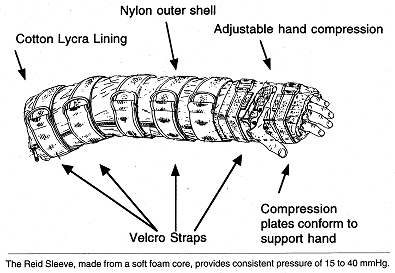Reid Sleeve Improves Chronic Lymphedema
ST. LOUIS-In a study of 31 breast cancer patients with chronic lymphedema who had failed other treatment methods, 27 showed significant improvement with use of the Reid Sleeve, a custom-designed pattern of soft polymer ridges that apply varying degrees of pressure, Diane Radford, MD, of Washington University, said in a poster presentation.
ST. LOUISIn a study of 31 breast cancer patients with chronic lymphedemawho had failed other treatment methods, 27 showed significant improvementwith use of the Reid Sleeve, a custom-designedpattern of soft polymer ridges that apply varying degrees of pressure,Diane Radford, MD, of Washington University, said in a poster presentation.

"Most of our patients had had multiple episodes of cellulitis whileusing either an elastic stocking or a compression pump device," Dr.Radford said. The study patients were advised to wear the custom-fittedReid Sleeve for eight hours a night while sleeping. Of the four patientswho did not improve, Dr. Radford said, two were noncompliant.
The 27 patients who showed improvement had a 3 cm average decrease incircumference at 10 cm above and below the elbow. In addition, the majorityof patients reported improvements in quality of life with use of the ReidSleeve.
Although the study was not controlled and follow-up is relatively short(mean, six weeks), Dr. Radford found the results very encouraging and suggestedthat a controlled trial, possibly with a crossover design, should be done.
Tony Reid, MD, a medical oncologist at Stanford University and the inventorof the Reid Sleeve, was also on hand to discuss the new device.
He made the first Sleeve about three years ago for a patient who wasspending much of her time on a mechanical pump. The device worked so wellfor her that she talked about it in her support group, and demand for theSleeve began to grow. "About a year ago, we started a lymphedema clinicat Stanford because of the number of patients seeking treatment, "Dr.Reid said.
He described a trial at Stanford, similar to Dr. Radford's study, thatinvolved 30 patients who had been on multiple therapies for severe lymphedemafor an average of eight to 10 years. Of those, 26 showed significant improvementwith the Reid Sleeve.
Dr. Reid said that the Sleeve is custom made for each patient, withVelcro straps to adjust the pressure, based on readings from a small compressiongauge. "We think it is critical to be able to adjust the pressure,since it is a fairly narrow range that provides the right pressure fora patient," he said.
He pointed out that lymphedema is "not a disease that will everreally go away," but with the Sleeve, he said, "patients haveimproved to the point where they don't rely on it on a daily basis anymore.The patient who has been on it the longest now uses it maybe once or twicea week."
He also noted that lymphedema can be more than just "unsightlyand cumbersome." In patients who develop cellulitis, it can also bea serious medical problem.
One patient, prior to using the Sleeve, had recurrent hospitalizationsfor infections, including several stays in the ICU because of sepsis fromthese infections. "Since starting on the Sleeve a year ago,"he said, "she has gone from a very enlarged, edematous red limb toone that now looks almost normal, and she hasn't had a single infection."
For more about the Reid Sleeve, contact www.noblemed.com on theInternetor call 1-800-29-EDEMA.